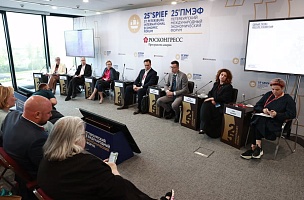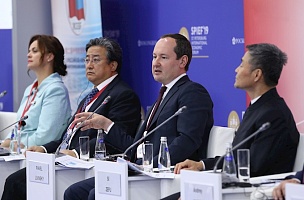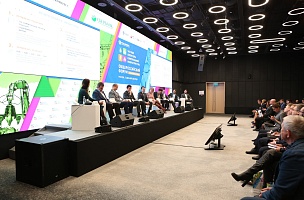Key findings
Laws often create additional barriers to integrated development
"The integrated development of territories should be spelt out in our legislation. There should be a recorded process of agglomeration, on which the development of territories is carried out. […] Barriers must be removed,” said Vladimir Koshelev, First Deputy Chairman of the Committee of the State Duma of the Federal Assembly of the Russian Federation for Construction, Housing and Communal Services.
"Comprehensiveness is not just about building a residential neighbourhood and financing its construction. It means creating an environment which is not just about living in a flat. People don't live in flats for a long time. They live in complexes because they have all the services they need, such as sports, a park, a restaurant, and an educational institution,” said Alexander Tarabrin, Head of VEB.RF’s Asset Management Department.
The state should be a partner for property builders and developers
"Construction is the driver of any infrastructural development. […] It is extremely important to work together with the regions to produce complete, accurate, verified data. People, businesses, professional market players, including builders and developers, need this data. They should not solve their problems without government involvement. The state should enter into a partnership,” said Elena Martynova, Deputy Head of the Federal Service for State Registration, Cadastre and Cartography (Rosreestr).
"We are not competing with other regions. We are competing with Yandex, with Wildberries, with other companies and their customer experience. And we, as a state, have to offer a comparable customer experience, and it's not an easy task,” said Dmitry Yalov, Deputy Chairman of the Leningrad Region Government, Chairman of the Committee on Economic Development and Investment Activity of the Leningrad Region.
Digitalization of databases will allow for more successful development of territories
"In order for us to quickly launch the new digital services that people need, it is very important that all data and all information is transferred to a machine-readable format. And this is historically accumulated data, which is at completely different levels," said Elena Martynova, Deputy Head of the Federal Service for State Registration, Cadastre and Cartography (Rosreestr).
"Digitalization of management. We are in favour of technologization of work with both the citizen and the investor,” said Dmitry Yalov, Deputy Chairman of the Leningrad Region Government, Chairman of the Committee on Economic Development and Investment Activity of the Leningrad Region.
PROBLEMS
“When we consider infrastructure initiatives, we know that there could be more projects if they were prepared faster and better. Many developers, businesses, and infrastructure companies face difficulties with the fact that there is no normal access to information if a project is regional or municipal. And sometimes they spend a huge amount of time trying to get the raw data for calculations. Today, we see a trend towards digitization of processes, especially databases, in certain regions and municipalities,” said Pavel Seleznev, General Director of the Public-Private Partnership Development Center.
Outdated laws and overloaded information systems should not hinder the development of new areas
“The entire legal framework was formed in already built-up areas, with established urban infrastructure and streets. All legislation on permits was shaped according to this logic. […] When we see integrated development of a territory, when a new district is built, which is comparable in size to the construction of a new city, this district can include several territories. It can be part of the city, part of the region. Then, there are the following problems: a school is built, people live there. But there are “paper" borders, such as city limits. For example, a school was built beyond the city limits. The school was included in the general layout of the newly built district, but people cannot take their children there. School, kindergarten, clinic. It is impossible to settle down there,” said Vladimir Koshelev, First Deputy Chairman of the Committee of the State Duma of the Federal Assembly of the Russian Federation for Construction, Housing and Communal Services.
“Our database on land and real estate is legally significant. This is the Unified State Register of Real Estate. It is a very large and complex system. There are 173 million properties in this system. The number is constantly growing, and the load on the system is growing,” said Elena Martynova, Deputy Head of the Federal Service for State Registration, Cadastre and Cartography (Rosreestr).
Train stations deny full use of urban space
“Generally, train stations in large cities are located in the central part of the metropolis. The nature of railways is such that the station area takes up a fairly large area of the ground surface, over which the rails are laid in the shape of a fan. […] These areas are insufficient in function because the space occupied is large, but there is only one function. The movement of trains. Apart from the fact that these areas look like gaps in the city, they functionally break up the urban area. Pedestrian and transport connections are difficult, and can only be made via bridges and overpasses. In architectural terms, such zones look like a failure,” says Alexey Danilenko, General Director of AC&AD Architectural Bureau.
SOLUTIONS
An integrated approach and a single digital platform will help to develop territories
“In all of our projects, we initially form the environment together with our partners, and then we attract tenants. Afterwards, we either sell these sites or hand them over to developers, which are financed when they are ready, comfortable, and fully operational. This is our systematic principle of activity. In large projects, it creates an environment for small and medium-sized businesses, and gives an opportunity to a huge number of companies and organizations, both public and private, to develop and work on these projects,” said Alexander Tarabrin, Head of VEB.RF’s Asset Management Department.
“On 7 June, the Government of the Russian Federation approved a decree on the creation of the Unified Digital Platform, called the National Spatial Data System. […] This platform will create about 12 vital different services specifically helping people. […] It is necessary to make a collection of all spatial data in one place,” said Elena Martynova, Deputy Head of the Federal Service for State Registration, Cadastre and Cartography (Rosreestr).
Construction and improvement of large-scale areas over train station infrastructure
“It is absolutely clear to us now, in terms of both land law and our corporate procedures, how to change such areas. We also see that, first of all, in certain parts of Moscow, there is demand for this type of construction. VEB.RF is implementing the Slava project near Belorussky Railway Station as part of an integrated development owned by VEB. There is a possibility of a large pedestrian zone being built directly above the tracks. It is already being designed. [...] Now such construction is possible, we are ready to provide areas for designing and creating facilities above the tracks," said Alexander Plutnik, Deputy Managing Director of Russian Railways.
Read more in the Roscongress Information and Analytical System roscongress.org






